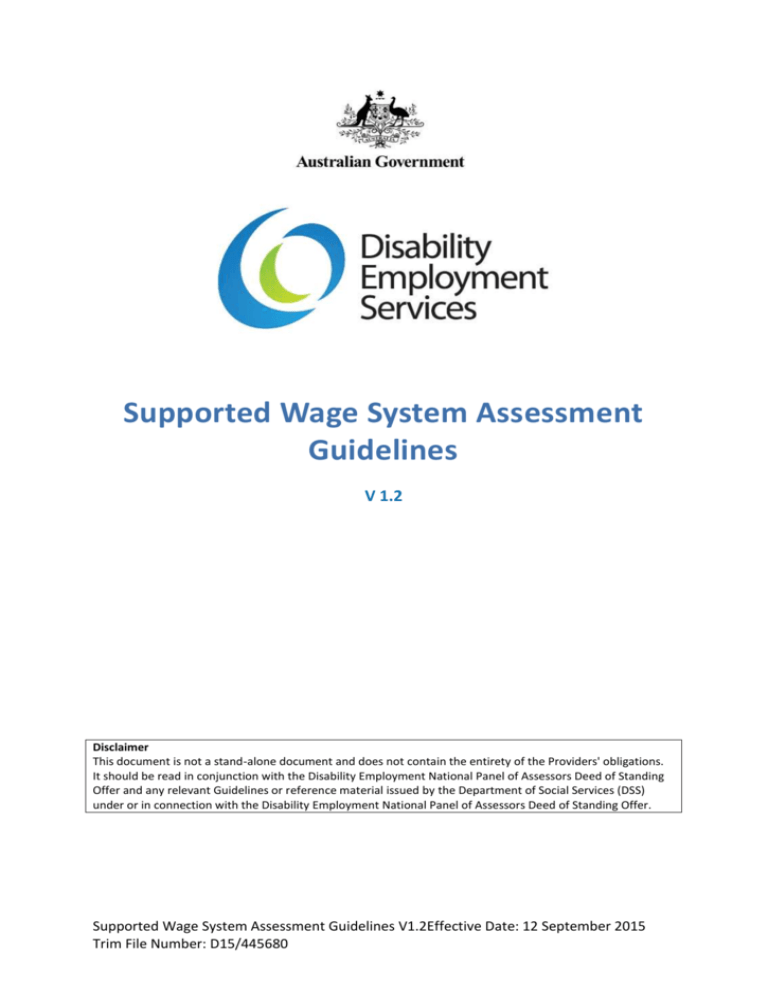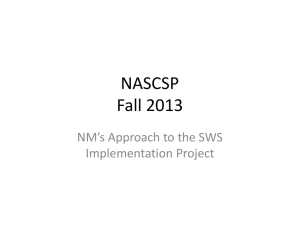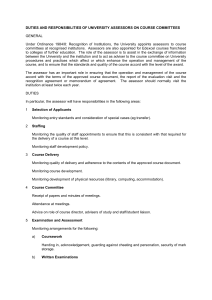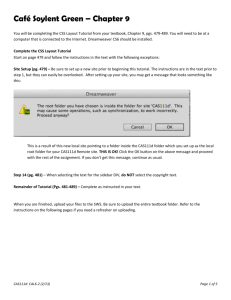Supported Wage System Assessment Guidelines
advertisement

Supported Wage System Assessment Guidelines V 1.2 Disclaimer This document is not a stand-alone document and does not contain the entirety of the Providers' obligations. It should be read in conjunction with the Disability Employment National Panel of Assessors Deed of Standing Offer and any relevant Guidelines or reference material issued by the Department of Social Services (DSS) under or in connection with the Disability Employment National Panel of Assessors Deed of Standing Offer. Supported Wage System Assessment Guidelines V1.2Effective Date: 12 September 2015 Trim File Number: D15/445680 Table of Contents Table of Contents 2 Document Change History: 3 Background 3 Summary 3 Flow Chart – Supported Wage System Assessment Guidelines: 5 Text version of Supported Wage System Assessment flow chart 5 Disability Employment National Panel of Assessors Deed of Standing Offer Clauses: 6 Reference documents relevant to these Guidelines: 6 Explanatory Note: 6 Supported Wage System Assessment Guidelines: 7 Supported Wage System Assessment Guidelines V1.2Effective Date: 12 September 2015 Trim File Number: D15/445680 Document Change History: Version Start Date Effective Date End Date Change & Location 1.2 12 Sept 15 12 Sept 15 1.1 01 Jul 12 01 Jul 12 11 Sep 15 Throughout Document: Deed references updated to 20122015. Some minor rewording for improved clarity. Reference Documents: Updated 1.0 15 Jan 10 01 Mar 10 30 Jun 12 Original version of document Throughout Document: Removed references to DEEWR and replaced with DSS Throughout Document: Updated references to Deed to remove 2012-2015 Throughout Document: Accessibility Changes Background These Guidelines outline the process for arranging and conducting a Supported Wage System (SWS) Assessment for a Participant who is registered with a Disability Employment Services (DES) provider (hereon referred to as ‘DES provider’). SWS Assessments are also available to people who are not registered with a DES provider. The Assessment process is very similar, except that the Assessor must work directly with the Employer to obtain information about the job. Assessors, Employers, service providers and other parties have access to comprehensive information about the SWS on the publically available website at JobAccess. This includes a SWS Handbook, task cards and instructions. The SWS Handbook is the key SWS document, and includes information on the industrial relations instruments and role of the Employer. Questions may be directed to the Department’s Supported Wage Management Unit (SWMU) on 1800 065 123. Industrial relations and wages information is available from the Fair Work Infoline on 13 13 94 or the website at Fair Work Ombudsman. Information about the SWS Minimum Weekly Wage is available from JobAccess, or the Fair Work Commission website at Fair Work Commission. Summary The Supported Wage System was introduced in 1994 to improve employment opportunities for people with disability. This followed consultation with the relevant industrial authorities, Employers, trade union and disability peak bodies, state and federal government departments and disability employment services. Many people with disability obtain employment at full award wages, but for others, the nature of disability can affect their productive capacity. People in such circumstances may wish to use a reliable process of productivity-based wage assessment to obtain a job in the Supported Wage System Assessment Guidelines V1.2Effective Date: 12 September 2015 Trim File Number: D15/445680 open labour market. The Supported Wage System was introduced to provide both the industrial relations framework and the Assessment process to enable reliable productivitybased wage assessments for eligible people with disability. The Department of Social Services (DSS) manages a National Panel of Assessors under the Disability Employment National Panel of Assessors Deed of Standing Offer to deliver a range of assessment services, including SWS Assessments. Supported Wage System Assessment Guidelines V1.2Effective Date: 12 September 2015 Trim File Number: D15/445680 Flow Chart – Supported Wage System Assessment Guidelines: 1. SWS provider receives a Work Order requesting a SWS Assessment be undertaken. 2. Assessor prepares for and arranges the SWS Assessment. 3. Assessor undertakes the SWS Assessment. 4. SWS Wage Assessment Agreement is prepared and signed. 5. Assessor sends a copy of the SWS Wage Assessment Agreement to the industrial authority. 6. SWS Assessment is completed on the Department’s IT System. Note: This should not be read as a stand-alone document, please refer to the Disability Employment National Panel of Assessors Deed of Standing Offer. Text version of Supported Wage System Assessment flow chart: Step 1: SWS provider receives a Work Order requesting a SWS Assessment be undertaken. Go to Step 2. Step 2: Assessor prepares for and arranges the SWS Assessment. Go to Step 3. Step 3: Assessor undertakes the SWS Assessment. Go to Step 4. Step 4: SWS Wage Assessment Agreement is prepared and signed. Go to Step 5. Step 5: Assessor sends a copy of the SWS Wage Assessment Agreement to the industrial authority. Go to Step 6. Step 6: SWS Assessment is completed on the Department’s IT System. Supported Wage System Assessment Guidelines V1.2Effective Date: 12 September 2015 Trim File Number: D15/445680 Disability Employment National Panel of Assessors Deed of Standing Offer Clauses: Clause 4 – Formation of Contracts Clause 7 – Conduct of Assessments Clause 9 – Provider’s Personnel Clause 50 – Conflict of Interest Clause 62 – The SWS Services Clause 63 – SWS Assessments Clause 64 – SWS Assessment Reports Clause 65 – SWS Fees Reference documents relevant to these Guidelines: Supported Wage System Handbook Supported Wage System Supporting Document Version 1.0 Explanatory Note: 1. 2. All capitalised terms have the same meaning as in the Disability Employment National Panel of Assessors Deed of Standing Offer. In this document, “must” means that compliance is mandatory and “should” means that compliance represents best practice. Supported Wage System Assessment Guidelines V1.2Effective Date: 12 September 2015 Trim File Number: D15/445680 Supported Wage System Assessment Guidelines: Who is Responsible: 1. SWS provider Receives a Work Order requesting a SWS Assessment be undertaken. Disability Employment National Panel of Assessors Deed of Standing Offer Clause References: Clause 4 Clause 13 Clause 50 2. Assessor Prepares for and arranges the SWS Assessment. Disability Employment National Panel of Assessors Deed of Standing Offer Clause References: Clause 7 Clause 9 Clause 62 Clause 63 Clause 64 What is Required: SWS providers may receive a Work Order on the Department’s IT System which will request the provider to complete a SWS Assessment. The provider: Regularly checks the Department’s IT System for any new Work Orders Accepts or rejects Work Orders within one Business Day of receiving a Work Order Records reasons for rejecting a Work Order, and Takes action to resolve any Conflict of interest that arises in connection with any Work Order. DSS may have regard to previous rejections of Work Orders when deciding whether to allocate further Work Orders to the provider. After accepting the Work Order on the Department’s IT System, the provider may allocate the Assessment to one of its Specified Personnel who has been approved as an Assessor by DSS and has completed the SWS online training modules. The Assessor will be able to determine from the Department’s IT system whether the SWS Assessment is an initial or a review assessment, and view the relevant background. if it is an initial assessment, the Assessor will access the details about the job, employee, Employer and applicant from the application screen, and if it is a review assessment, the Assessor will also access the details about the previous SWS Assessments completed for that employee. The Assessor will familiarise themselves with the relevant Assessment details on the Department’s IT system; particularly the work classification, nominated industrial instrument, duties, tasks and past productivity ratings, where relevant. The Assessor should check that the name of the Employer on the JobAccess SWS application screen is correct by confirming the details with the Employer and advise the DSS SWMU so that the details are amended. The Assessor contacts the DES provider (where there is one), and the Employer, to make arrangements for the Assessment; including: Supported Wage System Assessment Guidelines V1.2Effective Date: 12 September 2015 Trim File Number: D15/445680 agreeing on the time to conduct the SWS Assessment explaining to the Employer the SWS Assessment process confirming with the Employer if there are any special OH&S and building access requirements. confirming with the Employer and the DES provider who will be present during the SWS Assessment and whether there is a union representative. Ideally, the Assessor should develop rapport with all parties at a meeting before the SWS Assessment. It is particularly important to ensure that the employee knows when the SWS Assessment is to occur. The SWS Assessment should be undertaken at times and on days when the employee works. The employee should have the relevant tasks to do during the SWS Assessment. The Assessor should collect background information from the DES provider, where relevant, and verify this information with the Employer. The Assessor should collect, from the Employer and the DES provider, all the relevant information that is required to make a detailed SWS Assessment, including: job description task descriptions job and task analysis core tasks and miscellaneous a copy of the award or other industrial instrument under which the employee is employed time spent on each duty per week/fortnight hours/days worked task sequencing supervisor’s name/title allowable breaks employee performance information/specific performance issues busy and quiet period best times to take timings level/description of supervision required by client site/employee specific information relevant to conducting wage assessments safety requirements/OH&S considerations, and worksite access. Before an SWS Assessment is conducted, the Assessor should confirm with the Employer and DES provider that: all the necessary modifications to the work Supported Wage System Assessment Guidelines V1.2Effective Date: 12 September 2015 Trim File Number: D15/445680 environment and job have occurred to maximise the employee’s productivity there is an appropriate job match that appropriate training has been provided to the employee in all duties to be performed. This is especially important for initial assessments and for review assessment where the duties have recently changed, and it is agreed that the employee is unable to work at the productivity level that would be expected by the minimum standards for that position. Understanding the SWS Assessment Tool The Supported Wage System Assessment Tool (SWAT) has been developed after significant consultation and trialling and it provides a reliable method of assessing work productivity. The SWAT is accessed and completed online on the JobAccess secure website. The methodology focuses on observing and timing employees doing their work tasks. The Assessor uses all the information gathered about the job to identify the duties – the key outcomes or results; and the tasks – the smaller pieces of work that together make up the duty. For example, for the position of a room attendant in a motel, a duty could be to “clean the room”, and the tasks making up this duty would include things such as “make the bed”, “clean the bathroom”, “vacuum floor” and “dust furniture”. The Assessor must describe each task in sufficient detail so that anyone else would be able to observe and measure the task being performed in exactly the same manner. The Assessor must document a description of the task so that the tasks are: observable measurable replicable, and have a clear beginning and end. The task description is particularly important for the 12 month review, when a different Assessor may be conducting the SWS Assessment. There must be enough information in the SWS Assessment Report about the standard that was set, so that another Assessor reviewing the employee’s productivity 12 months later can assess if productivity has changed. Supported Wage System Assessment Guidelines V1.2Effective Date: 12 September 2015 Trim File Number: D15/445680 The Assessor must confirm if there are any duties that are performed at 100% productivity. If there are duties performed at 100%, the Assessor must not time these duties, but should include them in the productivity calculation so that the final productivity result accurately and fairly reflects the employee’s performance in all their duties. The Assessor must assess the duties that are actually performed by the employee, even if there are more or less duties on the duty description. Jobs are often modified for people with disability and therefore standard position descriptions will not always fully reflect the duties actually performed by the employee with disability. The Assessor, the Employer and any other parties to the SWS Wage Assessment Agreement must agree on the duties to be assessed before proceeding with the Assessment. Establishing the basic performance standard The SWS Assessment requires a basic performance standard to be set. This is the minimum work performance standard that the Employer will accept to pay the full award wage. The Assessor must discuss with the Employer the selection of a suitable co-worker to use to time as a method of establishing the basic performance standard. Do not select the highest or lowest performing co-worker. Even the average performing co-worker may be doing more than the basic performance level required. It is the basic performance standard considered as the minimum performance acceptable to the Employer that must be established. 3. Assessor Undertakes the SWS Assessment Disability Employment National Panel of Assessors Deed of Standing Offer Clause References: Clause 7 Clause 63 Clause 64 The Assessor should phone the Employer within 12 hours of the agreed time to conduct the Assessment and confirm with the Employer that the Assessment will be conducted at the agreed time. The Assessor should explain the Assessment procedure and the need for timings to the Employer and any other parties with whom the Assessment process has not already been discussed. The Assessor should put the employee at ease and take care to make the Assessment as stress-free as possible. Observe and time performance Using the agreed duty and task description and basic performance standard, the Assessor will observe and time the employee doing their tasks, allowing the employee to stop and repeat the process if something has unduly affected their productivity. Interruptions may be common in busy customer focussed work environments such as a busy supermarket and the Assessor may need to repeat their Supported Wage System Assessment Guidelines V1.2Effective Date: 12 September 2015 Trim File Number: D15/445680 timings. The Assessor should maintain a flexible approach when taking timings and continue to take timings until satisfied there is a good consistency in results and an accurate measurement of work productivity. The Assessor should not time breaks if they conform to what is accepted in the workplace, however, unacceptable time away from tasks should be included and timed as a part of the duty in which it occurs. Acceptable breaks can be counted at 100% (e.g. meetings, morning tea break). The Assessor must always measure exactly the same thing for the employee as they did when setting the basic standard. For example, if the basic performance standard was set during a very busy time of the day, the employee’s productivity must be measured at a similar busy time, where relevant. The employee should have the same level of supervision during the SWS Assessment as they normally would while doing their tasks. How to do time weightings The Assessor must ascribe a time to all duties, even those performed at 100% productivity. The Assessor must give a weighting to each duty the employee performs according to the amount of time spent on that duty (usually per week, but could be per day or fortnight). Duties are time weighted so that lower productivity on a minor duty (or vice versa) does not unduly affect the wage rate. Example of Time Weighting An employee in a plant nursery spends 60% of her time on one duty at which she achieves 70% of full award level productivity. She spends 30% of her time on a second duty in which she achieves 50% of full award level productivity. The remainder of her time is spent on a duty in which her productivity is 40% of the standard. Without a time weighting, her productivity rating would be 53% - an average of the comparative timings of 70%, 50% and 40%, e.g. Duty 1 – 70% Duty 2 – 50% Duty 3 – 40% Result – 53% With a time weighting, the person’s productivity rating (without supervision or other adjustment) is 61%, e.g. Supported Wage System Assessment Guidelines V1.2Effective Date: 12 September 2015 Trim File Number: D15/445680 Duty 1 – 0.7 (70%) x 0.6 (60%) = 0.42 (42%) Duty 2 – 0.5 (50%) x 0.3 (30%) = 0.15 (15%) Duty 3 – 0.4 (40%) x 0.1 (10%) = 0.04 (4%) Result – 0.61 (61%) If required, the Assessor must request any existing information from the DES provider and the Employer to verify the amount of time spent on each duty. If the amount of time spent on each duty fluctuates, the parties to the Assessment may agree to use an average time per week. Rounding The Assessor must round each productivity assessment calculation to 2 decimal places, i.e. all productivity results for duties and tasks must be recorded to 2 decimal places. The productivity rate for each duty must be added and then the total productivity rate must be rounded to the nearest whole decile that best reflects the employee’s total productivity (e.g. usually 53% would be rounded to 50% and 55+% would be rounded to 60%. If the Assessor considers that the employee requires significantly more supervision from their Employer than is required in the minimum basic standard, the Assessor may round an overall productivity rating down to the nearest whole decile (e.g. the 57% rating could be rounded to 50% if there is significantly more supervision required. Conversely, a productivity rating may be rounded up if the employee is highly focussed and a steady worker, e.g. a 53% rate could be rounded to 60%). The Assessor should carefully consider any rounding that is other than to the nearest whole decile and in particular, should only make the decisions to round down when it is very clear that there is a high level of supervision required. Any rounding must be within the percentile band in which it falls. After the final SWS productivity rating, including any rounding that is calculated, the Assessor discusses the result with the Employer and other parties to the SWS Wage Assessment Agreement and confirms the final rating. If any parties dispute the rating made as a result of the SWS Assessment, at the Assessment, the Assessor should work with the parties to resolve the dispute. Some things that the Assessor can do, include: conduct more timings, if the dispute relates to the results of particular duties reconsider the rounding decision, taking into Supported Wage System Assessment Guidelines V1.2Effective Date: 12 September 2015 Trim File Number: D15/445680 4. Assessor SWS Wage Assessment Agreement is prepared and signed Disability Employment National Panel of Assessors Deed of Standing Offer Clause References: Clause 7 Clause 64 consideration the views of all the parties to the SWS Wage Assessment Agreement, or if any party to the SWS Wage Assessment Agreement still wishes to dispute the result they should contact their local DSS Supported Wage Management Unit (SWMU) who will either provide the party with the details of how to submit a request for a review of the Assessment; or if their dispute relates to industrial relations matters, direct them to the relevant industrial relations authority which has jurisdiction in the matter. After the Assessor has determined the final total SWS productivity rating, which the employee, Employer and any other parties to the SWS Wage Assessment Agreement have agreed to, the following things must happen: the Assessor enters the productivity rate into the SWS Wage Assessment Agreement the Employer uses the agreed SWS productivity rate to calculate the SWS pro-rata weekly wage, applicable to the classification of work in which the employee is being employed the Assessor enters the SWS weekly wage rate in the SWS Wage Assessment Agreement, and the Assessor must ensure that the amount entered in the SWS Wage Assessment Agreement is not below the SWS Minimum Weekly Wage, as determined by the Annual Wage Review. The current SWS Minimum Wage is available from the JobAccess and Fair Work Commission websites. The Assessor should inform the Employer that they need to advise the DSS SWMU if the industrial instrument expires or is replaced by a new one. The Assessor should provide a copy of the signed SWS Wage Assessment Agreement to the Employer and employee, and the employee’s nominee who is a party to the SWS Wage Assessment Agreement, if they request a copy. The Assessor may also provide a copy to the DES provider, with the consent of the employee. The Assessor should advise the parties to the SWS Wage Assessment Agreement that a new SWS Assessment will occur in 12 months time, or earlier if the employee’s productivity has either significantly increased or declined, or if there has been a significant change in duties. In such cases, any party to the SWS Wage Assessment Agreement may Supported Wage System Assessment Guidelines V1.2Effective Date: 12 September 2015 Trim File Number: D15/445680 request a review assessment by contacting the DSS SWMU. 5. Assessor Assessor sends a copy of the SWS Wage Assessment Agreement to the industrial authority, where relevant. On behalf of the Employer, the Assessor sends a copy of the SWS Wage Assessment Agreement to the relevant industrial authority, where required by the industrial relations SWS provisions. if the relevant industrial instrument containing the SWS provisions is a Federal instrument, the SWS Wage Assessment Agreement is sent to Fair Work Commission. if the relevant industrial instrument containing the SWS provisions is a State instrument, the SWS Wage Assessment Agreement is usually sent to the relevant State Government Industrial Registrar. Assessors should check the signed SWS Wage Assessment Agreement thoroughly before sending it to the industrial authority, as this will ensure that only valid agreements are signed and lodged. The Assessor should obtain the details of any requirements to lodge the SWS Wage Assessment Agreement by checking the industrial instrument which is being used as the basis to employ the person and/or by checking with the Fair Work Infoline or the Fair Work Ombudsman website. Refer to the SWS Handbook for more information. 6. Assessor The Assessor enters the details of the SWS Assessment and Assessment is submitted on the date the SWS Wage Assessment Agreement was signed the Department’s IT System into the Department’s IT System. This must be submitted within 7 business days of the date the Assessment is Disability Employment conducted. National Panel of Assessors If DSS reasonably considers a SWS Assessment or SWS Deed of Standing Offer Assessment Report is unsatisfactory or incomplete, the Clause References: provider may be required to conduct a further SWS Clause 7 Assessment in whole or in part or resubmit a revised SWS Clause 64 Assessment Report. This will be done without any additional Clause 65 charges or Fees. Once DSS accepts the SWS Assessment Report, the relevant provider may claim the SWS Assessment Fee. Where the SWS Assessment and SWS Assessment Report will jointly take more than 5 hours to complete, the provider may apply to DSS for additional Fees. Where the provider seeks DSS’s agreement to pay the additional Fees, the provider must meet additional Supported Wage System Assessment Guidelines V1.2Effective Date: 12 September 2015 Trim File Number: D15/445680 requirements. Apart from the above, no further payments or reimbursements will be made by DSS to the provider for the Service. Supported Wage System Assessment Guidelines V1.2Effective Date: 12 September 2015 Trim File Number: D15/445680






